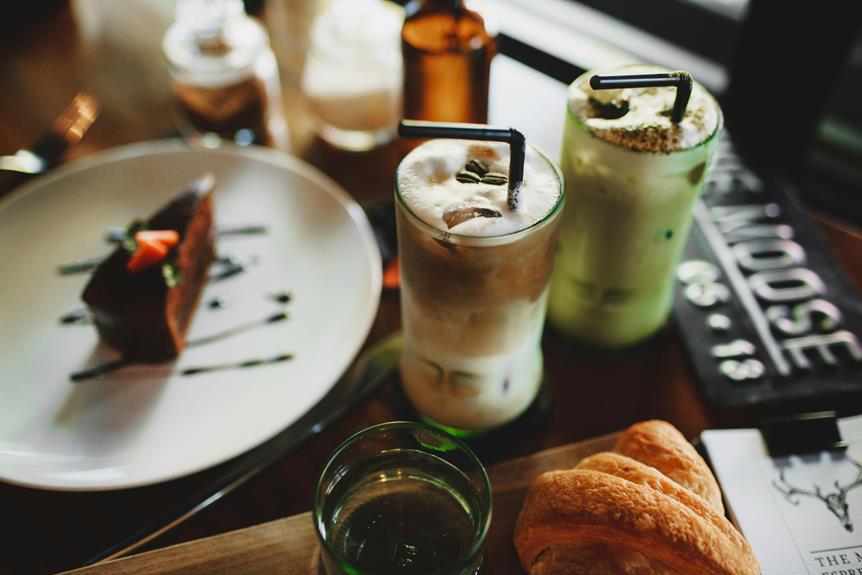When you take a sip of Vietnamese coffee, you're experiencing a unique fusion of French colonial history and local flavors, with sweetened condensed milk magically balancing out the bold, rich notes of expertly brewed coffee. You'll discover that this coffee culture is steeped in tradition, from the careful selection of Arabica and Robusta beans to the precise brewing process that requires patience and practice. As you indulge in the sweet and rich harmony, you'll want to explore more about the intricate flavors, cultural significance, and expert techniques that make Vietnamese coffee a true delight – and there's so much more to discover.
Key Takeaways
- Vietnamese coffee's unique flavor profile is enhanced by sweetened condensed milk, balancing bold flavors with a sweet and creamy contrast.
- The milk's sweetness complements the coffee's bitterness, creating a harmonious blend of rich and sweet notes.
- Sweetened condensed milk is an essential component of traditional Vietnamese coffee, adding a luxurious feel to every cup.
- The creamy texture of sweetened condensed milk helps to bring out the flavors of the coffee, making every cup a flavor sensation.
- Vietnamese coffee and sweetened condensed milk are inseparable, with the milk playing a vital role in the country's coffee culture and tradition.
The Origins of Vietnamese Coffee
Vietnamese coffee has a rich history that dates back to the French colonial era in the mid-19th century, when the first coffee plants were introduced to the country.
During this time, French colonization brought about significant changes to Vietnam's economy and culture. One of these changes was the establishment of coffee plantations in the central highlands, which would eventually become a major coffee-producing region.
As the French expanded their trade routes, they brought coffee beans from other colonies to Vietnam, experimenting with different varieties to find ones that would thrive in the local climate.
You'll notice that Vietnamese coffee is often described as having a distinct flavor profile, which is partly due to the country's unique terroir and the French influence on its coffee production.
The French colonization of Vietnam also led to the creation of a new coffee culture, with cafes and coffee shops springing up in urban centers.
This marked the beginning of Vietnam's love affair with coffee, which would continue to grow and evolve over the years.
As you explore further into the world of Vietnamese coffee, you'll discover how this rich history has shaped the country's coffee traditions and preferences.
Rich Flavors and Aromatic Notes
As you savor a cup of Vietnamese coffee, the complex flavors and aromas that have been shaped by the country's unique terroir and French influence are likely to captivate your senses.
The flavor profiles of Vietnamese coffee are known for their rich, bold, and smooth characteristics, with notes of chocolate, caramel, and nuts. This is largely due to the country's careful bean selection, which prioritizes high-quality Arabica and Robusta beans grown in the central highlands.
You may detect hints of fruit and spices, which are a result of the country's diverse growing regions and processing methods. The French influence is also evident in the coffee's subtle acidity and balanced body.
As you take another sip, you'll notice how the flavors unfold, revealing a depth and complexity that's hard to find in other coffee-producing countries.
Whether you're a coffee connoisseur or just a casual fan, Vietnamese coffee's rich flavors and aromatic notes are sure to leave a lasting impression.
Sweetened Condensed Milk Magic
Frequently, the rich flavors of Vietnamese coffee are elevated to new heights by the addition of sweetened condensed milk, a creamy and indulgent complement that has become an integral part of the country's coffee culture.
As you sip on a cup of Vietnamese coffee, you'll notice how the sweetened condensed milk balances out the bold flavors of the coffee, creating a delightful harmony of sweet and rich notes.
It adds a velvety smooth texture to your coffee, making every sip a pleasure.
The sweetness of the condensed milk complements the bitterness of the coffee, creating a sweet combination that's hard to resist.
The milk textures play a vital role in Vietnamese coffee, with the creamy condensed milk adding a luxurious feel to every cup.
You can adjust the amount of sweetened condensed milk to your taste, making it a highly customizable coffee experience.
The sweetness of the condensed milk helps to bring out the flavors of the coffee, making every cup a flavor sensation.
The Art of Coffee Brewing
Brewing Vietnamese coffee is an art form that requires precision, patience, and practice to perfect the delicate balance of flavors and textures.
You'll need to start with high-quality coffee beans that have been expertly roasted to bring out the unique flavors of Vietnamese coffee. Look for beans that have been roasted to a dark French or Italian roast, as this will give your coffee a rich, bold flavor.
Once you have your beans, it's time to grind them. You'll want to use a medium-coarse grind to allow for the perfect extraction.
Now, it's time to brew. Vietnamese coffee is typically brewed using a small metal filter called a phin. This filter allows the coffee to drip slowly, which helps to bring out the rich flavors of the coffee.
As you wait for your coffee to brew, you can't help but anticipate the rich, bold flavors that are about to be released.
With the right coffee roasting and brewing techniques, you'll be able to create a cup of Vietnamese coffee that's truly exceptional.
A Cup of Culture and Tradition
You hold in your hands a cup of rich, bold coffee that's not just a drink, but a symbol of Vietnamese culture and tradition. As you take a sip, you're not just tasting the coffee, you're experiencing a piece of history and community. Vietnamese coffee is often served at social gatherings, where it's customary to share a cup with friends and family.
Coffee Etiquette: In Vietnam, it's considered impolite to leave a coffee shop or cafe without finishing your drink. It's a sign of respect to the host and the coffee itself.
Family Heirlooms: Traditional Vietnamese coffee filters, called phins, are often passed down from generation to generation as family heirlooms.
Coffee is an integral part of Vietnamese daily life, with many families gathering around the coffee table to share stories and bond.
In Vietnam, coffee is often served as a sign of hospitality to guests.
The traditional Vietnamese coffee-making process is a labor of love, requiring patience and care to produce the perfect cup.
As you savor your Vietnamese coffee, remember the rich cultural heritage behind it.
Popular Coffee Shops and Cafes
As you wander through Vietnam's bustling streets, you'll stumble upon cozy coffee shops and charming cafes that have become institutions in their own right.
These popular hangouts are a hub for socializing, working, and of course, sipping on a rich cup of Vietnamese coffee.
You'll notice that each cafe has its own unique vibe, reflecting the country's coffee trends.
From trendy spots with industrial-chic decor to quaint, family-owned shops with vintage flair, there's a cafe atmosphere to suit every taste.
In Hanoi, you might stumble upon Cafe Pho Co, a hidden gem with a picturesque view of Hoan Kiem Lake.
In Ho Chi Minh City, you could find yourself at L'Usine, a stylish cafe with a passion for artisanal coffee.
Wherever you go, expect to be surrounded by locals and travelers alike, all united by their love of good coffee and good company.
DIY Vietnamese Coffee at Home
Now that you've experienced the vibrant cafe scene in Vietnam, it's time to recreate the flavors and aromas of Vietnamese coffee in the comfort of your own home.
With a few simple tools and ingredients, you can brew a cup that rivals those found in Hanoi's Old Quarter.
A medium to dark roast coffee bean is needed, which provides a richer flavor profile.
A Coffee Grinder is necessary to freshly grind your beans before each brew.
A phin filter or a French drip coffee maker is required to slowly extract the coffee's flavors.
Sweetened condensed milk is needed to add a creamy, sweet contrast to the bold coffee.
Ice is necessary to chill and dilute the coffee to your desired strength.
Coffee Culture Beyond Vietnam
Beyond Vietnam's borders, coffee cultures in other Southeast Asian countries, such as Thailand and Indonesia, have also developed unique brewing methods and traditions that are worth exploring.
You might be surprised to find that these countries have their own twist on coffee, often blending traditional techniques with modern flavors.
In Thailand, for instance, you can find coffee served over ice with sweetened condensed milk, similar to Vietnam's signature style.
Indonesia, on the other hand, is famous for its Kopi Luwak, one of the world's most expensive coffee varieties.
As you venture into the world of coffee beyond Vietnam, you'll notice that global trends are shaping local coffee cultures.
The rise of coffee tourism has led to an increase in specialty coffee shops and cafes, offering visitors a unique coffee experience.
You can visit coffee plantations, attend coffee workshops, and even stay at coffee-themed resorts.
Whether you're a coffee connoisseur or just a curious traveler, exploring coffee cultures in Southeast Asia is a must-do experience.
Frequently Asked Questions
Can I Use Low-Fat or Non-Dairy Milk Alternatives in Vietnamese Coffee?
You can experiment with low-fat or non-dairy milk options, but be aware that they'll alter the flavor profiles. Non-dairy milks might lack richness, while low-fat milks could dilute the sweetness, so adjust to taste.
How Do I Store Sweetened Condensed Milk to Maintain Freshness?
You're the guardian of a precious treasure, sweetened condensed milk, and its freshness depends on you. Store it in an airtight container on a cool, dry Milk Shelf or in a well-organized Pantry, and it'll remain your loyal companion.
Are Vietnamese Coffee Beans Different From Other Coffee Beans?
You'll find that coffee beans from different regions have distinct flavor profiles, and Vietnamese beans are no exception. They often come from high-altitude regions like Ethiopia, with brighter acidity and fruitier notes, setting them apart from other beans.
Can I Brew Vietnamese Coffee Without a Specialized Filter?
"Silky sips await! Yes, you can brew Vietnamese coffee without a specialized filter. Try a coffee hack: use a metal or paper filter substitute, and voila! Rich flavors flow, sans fancy equipment, in your clever coffee creations."
Is Vietnamese Coffee Served Cold or Hot Traditionally?
You'll find that traditionally, coffee is served hot in most Asian cultures, but when it comes to Vietnamese coffee, regional variations come into play, and it's often served over ice, which holds significant cultural significance in the country.
Conclusion
As you finish your cup of Vietnamese coffee, you're not alone.
70% of the world's coffee beans are consumed in Asia, with Vietnam being the second-largest coffee producer globally!
The rich flavors, aromatic notes, and sweetened condensed milk magic have captured your heart.
You've learned the art of brewing, the cultural significance, and even how to DIY at home.
Now, go forth and spread the love for this delicious coffee culture that's taking the world by storm!









